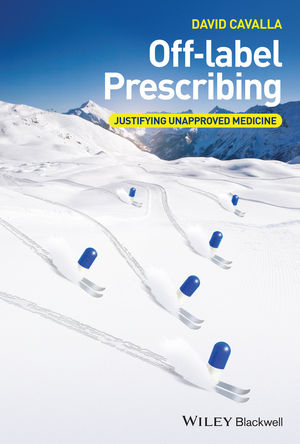
Off-label Prescribing
Wiley-Blackwell (Verlag)
978-1-118-91207-2 (ISBN)
- Titel z.Zt. nicht lieferbar
- Versandkostenfrei innerhalb Deutschlands
- Auch auf Rechnung
- Verfügbarkeit in der Filiale vor Ort prüfen
- Artikel merken
Today’s medicines are regulated for their efficacy and safety and, once approved, they can be marketed for certain uses as justified by the data. Regulatory bodies in developed countries are constituted by legal statute and operate as parts of government, ostensibly in the interests of the people as patients.
But once approved, medicines can be used for any purpose the prescriber thinks fit and appropriate for the patient. One in five prescriptions is therefore written outside regulatory purview.
Off-label Prescribing looks into the corners of our medicated lives, where drug regulation runs up against medical practice, and concerns the use of a drug that has been approved for one use (in medical parlance, ‘indication’) being used for a different indication; alternatively, being used on a different set of patients from the ones it is approved for, or at a different dose. Usually the patient is unaware of what is going on, having not been informed by their doctor of this aspect of his or her prescribing choice.
The book examines how and why this occurs, what the various medical professions have to say about it, and how pharmaceutical companies benefit by moving into this poorly regulated area. Off-label Prescribing pulls these complex issues together in one volume, to highlight current practice, its advantages and weaknesses and how the author suggests practice should evolve in the future. It will therefore be of interest to all those who prescribe (and receive) medicines, combined with a greater objective to provide more transparency and discussion for professionals.
David Cavalla, is an expert on secondary uses for existing drugs, or drug repurposing. He currrently operates through his consultancy, Numedicus Ltd, having worked in drug repurposing for 15 years. Previously he was CEO of Arachnova, and prior to that held various senior positions in pharmaceutical drug discovery at GSK and Napp Research Centre. He has written widely on drug discovery strategy, and is the author of 70 published papers and patents.
Foreword, ix
Acknowledgement, xi
Author’s note on the cover design, xiii
Introduction, xv
1 What is off-label medication, and how prevalent is it?, 1
What is ‘off-label’ medicine?, 2
Scope of the issue, 8
2 Where it all went right: new uses for existing drugs supported by good evidence, 19
Examples where products have been through regulatory approval for a secondary use, 19
Finasteride: pseudohermaphroditism and hair growth, 19
Sildenafil: re-tasking the blue pill for a life-threatening illness, 21
Doxycycline: from killing bugs to protecting gums, 22
Raloxifene: from cancer to bone disease and back again, 23
Galantamine: using snowdrops to improve memory, 24
Cyclosporine: preventing immune attack on organs and skin, 25
Dimethyl fumarate: a remarkable drug for multiple sclerosis, 26
Botox: a drug to kill or cure you, 27
Examples where evidence is uncertain and not to regulatory standards, 28
Tricyclic antidepressants: for curing more than emotional pain, 28
Aspirin for cancer, 30
Retrospective data: looking back to create future therapies, 30
3 Shared decision making and consent, 33
Viewpoint of the patient, 34
Viewpoint of the prescriber, 37
Professional guidelines, 38
Patient awareness, 41
Practitioner attitudes, 41
Diagnosis, 44
4 Gaming the system: the role of the pharmaceutical industry, 47
Normal drug development and drug repurposing development, 48
Gaming the system, 53
Orphan use, 56
Pharmaceutical marketing, 61
Expanding uses for non-pharmaceuticals, 64
DTC advertising, 64
Patents and genericisation, 65
Conclusion, 68
5 Do no harm: Safety and efficacy, 71
Relative safety, 73
Different therapeutic uses, 73
Chronic versus acute dosing, 78
Different dose, 81
Differences between children and adults, 82
Other patient populations, 86
Fatal ADRs, 87
Quality of evidence, 88
Strong evidence, 89
Poor evidence, 91
Doctors do not know evidence, 94
Proximity of off-label to on-label, 96
Debunking medical myths, 101
6 Liability, injustice and reimbursement: who should pay?, 105
A prescriber’s ethical and professional duties, 105
Medical professional participation in off-label promotion, 105
A prescriber’s legal position, 106
Consent, 106
Liability, 111
Reimbursement, 113
Compendia, 115
NICE, 117
Compassionate access, 120
Cost, as a driver for off-label medicine, 121
7 The role of regulation in off-label medicine, 125
Regulators do not regulate medical practice, 126
Off-label marketing, 128
Off-label fines, 130
Whistle-blowers, 134
European situation, 134
Tip of the iceberg, 136
Free speech, 138
8 Justifying unapproved medicine, 143
Constraints on making changes, 144
Moves to enhance off-label medicine, 145
Diagnosis shifting, 146
A partial solution: clinical trial transparency, 147
A solution based on increased regulatory supervision, 152
My solutions, 153
Professional standards, 153
Reimbursement and pricing, 156
Outcomes, 159
Conclusion, 173
References, 175
Index, 191
| Erscheint lt. Verlag | 20.2.2015 |
|---|---|
| Verlagsort | Hoboken |
| Sprache | englisch |
| Maße | 177 x 252 mm |
| Gewicht | 494 g |
| Themenwelt | Medizin / Pharmazie ► Medizinische Fachgebiete ► Medizinethik |
| Medizin / Pharmazie ► Medizinische Fachgebiete ► Pharmakologie / Pharmakotherapie | |
| Studium ► Querschnittsbereiche ► Geschichte / Ethik der Medizin | |
| Naturwissenschaften ► Biologie | |
| Naturwissenschaften ► Chemie | |
| ISBN-10 | 1-118-91207-1 / 1118912071 |
| ISBN-13 | 978-1-118-91207-2 / 9781118912072 |
| Zustand | Neuware |
| Haben Sie eine Frage zum Produkt? |
aus dem Bereich


